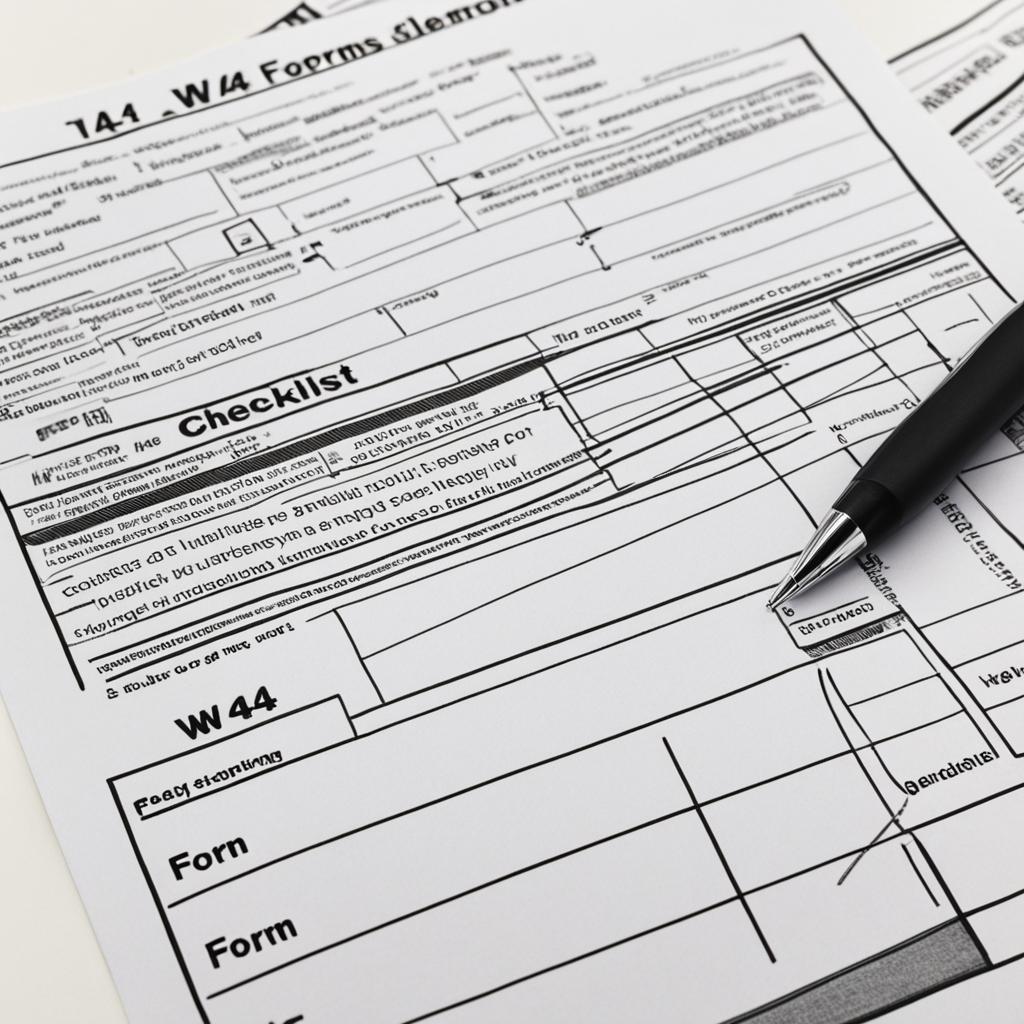Are you ready to take control of your tax withholdings and optimize your financial situation? Filling out a W-4 form is a vital step in determining the amount of federal income tax withheld from your paycheck. In this article, I will guide you through the entire process, providing clear instructions and helpful tips along the way.
Before we begin, let’s make sure we’re on the same page. I assume you’re here because you want to learn how to fill out a W-4 form, understand the instructions, and complete it accurately. Well, you’re in the right place!
First things first, let me familiarize you with the purpose of the W-4 form. It serves as a way for you to provide your employer with essential information about your tax situation. By completing this form correctly, you can ensure that the appropriate amount of tax is withheld from your paycheck, avoiding any unpleasant surprises when tax season rolls around.
Now, let’s dive into the step-by-step process of filling out a W-4 form. I’ll walk you through each section, explaining what information to provide and highlighting any key considerations. By the end, you’ll be armed with the knowledge and confidence to tackle your W-4 form with ease.
Key Takeaways:
- Understanding the purpose of the W-4 form is crucial for accurate tax withholdings.
- By following a step-by-step guide, you can effectively fill out your W-4 form.
- Considerations such as tax filing status, dependents, and other income or deductions impact your withholdings.
- Regularly review and update your W-4 form to reflect life events or changes in your financial situation.
- Seeking professional help can provide valuable guidance for optimizing your W-4 form.
Understanding the Importance of the W-4 Form
The W-4 form is a crucial document that directly impacts the amount of federal income tax withheld from your paycheck. It plays a significant role in determining your potential tax refund. By accurately filling out the W-4 form, you can optimize your tax withholdings and ensure that you are not withholding too much or too little throughout the year.
When you complete the W-4 form, you provide important information to your employer about how much tax should be withheld from your paycheck. This form allows you to indicate your filing status, number of dependents, and any additional income or deductions. All of these factors contribute to determining the appropriate amount of tax that should be withheld from your earnings.
By understanding the importance of the W-4 form, you can take control of your tax withholdings and potentially increase your tax refund or maximize your paycheck. It is essential to accurately fill out the W-4 form to avoid any surprises at tax time and ensure that you are complying with tax regulations.
Optimizing Your Tax Withholdings
“Properly completing the W-4 form allows you to optimize your tax withholdings. By tailoring your withholdings to your specific financial situation, you can avoid overpaying or underpaying your taxes throughout the year, and potentially increase your tax refund or maximize your paycheck.”
With accurate tax withholdings, you can make the most of your hard-earned money. If you withhold too much, you may receive a significant refund, but you are essentially loaning the government your money interest-free. On the other hand, if you withhold too little, you may end up owing a large sum of money at tax time, which can lead to financial stress.
Understanding the W-4 form and its impact on your tax withholdings empowers you to make informed decisions about your finances. By considering factors such as your filing status, dependents, additional income, and deductions, you can ensure that the right amount of tax is withheld from your paycheck.
Calculating Your Potential Tax Refund
“Accurate completion of the W-4 form can help you estimate and potentially increase your tax refund. By providing the right information, you can ensure that you are taking advantage of all available tax credits and deductions.”
When you accurately fill out the W-4 form, you provide information about your dependents, which can make you eligible for various child-related tax credits. Additionally, documenting any other deductions or credits you qualify for can further increase your potential tax refund.
Remember, a tax refund is essentially the return of money that you overpaid throughout the year. Optimizing your tax withholdings can help you minimize your tax liability and potentially receive a larger refund.
Understanding the importance of the W-4 form is crucial for managing your tax withholdings effectively. By accurately completing this form, you can optimize your tax withholdings and potentially increase your tax refund or maximize your paycheck. It is essential to consider your unique financial situation and review your W-4 form regularly to ensure that it aligns with your goals.
Image:
Steps to Fill Out a W-4 Form
Filling out a W-4 form is a crucial part of ensuring accurate tax withholdings from your paycheck. To help you navigate this process, here is a step-by-step guide on how to fill out a W-4 form.
- Start by providing your personal information:
- Your full name
- Your address
- Your Social Security number
- Single
- Married filing jointly
- Married filing separately
- Qualifying surviving spouse
- Head of household
Note: Deductions are expenses that can reduce your taxable income, while dependents are individuals who rely on you financially.
Note: This includes income from a second job, freelance work, or investments, as well as deductions such as student loan interest or mortgage interest.
Note: Make sure to review the form for accuracy before submitting it to your employer.
By following these steps and providing the necessary information, you can complete your W-4 form with confidence and ensure that your tax withholdings align with your financial situation.
W-4 Form Instructions
| Step | Instructions |
|---|---|
| 1 | Provide your personal information: full name, address, and Social Security number. |
| 2 | Choose your tax filing status: single, married filing jointly, married filing separately, qualifying surviving spouse, or head of household. |
| 3 | Determine the number of deductions and dependents you have. |
| 4 | Indicate any additional income or deductions. |
| 5 | Sign and date the form before submitting it to your employer. |
Choosing Your Tax Filing Status
When filling out a W-4 form, one of the key decisions you will need to make is determining your tax filing status. This selection plays a significant role in the amount of tax that will be withheld from your paycheck. It is crucial to choose the filing status that accurately reflects your situation to ensure proper tax withholding.
Understanding Tax Filing Status Options
When completing your W-4 form, you will come across several tax filing status options. These include:
- Single: Select this option if you are not married or if you are married but choose to file separately.
- Married Filing Jointly: Choose this status if you are married and plan to file a joint tax return with your spouse.
- Married Filing Separately: Opt for this option if you are married but wish to file separately from your spouse.
- Qualifying Surviving Spouse: If your spouse passed away during the previous tax year and you have a dependent child, you may qualify for this status. It provides certain benefits similar to the Married Filing Jointly status.
- Head of Household: This status is available for individuals who are unmarried, have a qualifying child or dependent, and meet other eligibility requirements.
Each tax filing status has different tax brackets and standard deductions. Therefore, it is essential to understand the implications of each option and choose the one that fits your circumstances best.
Choosing the Right Tax Filing Status
When selecting your tax filing status, consider your marital status, dependents, and other relevant factors. For example, if you are married and both you and your spouse work, comparing the Married Filing Jointly and Married Filing Separately statuses can help determine which one offers the most advantageous tax outcome.
It’s worth noting that choosing the right tax filing status can have a significant impact on your tax withholding. Failing to select the appropriate status may result in over or under withholding, leading to a potential tax bill or missed refund opportunities.
| Tax Filing Status | Tax Brackets | Standard Deduction |
|---|---|---|
| Single | 10%, 12%, 22%, 24%, 32%, 35%, 37% | $12,550 |
| Married Filing Jointly | 10%, 12%, 22%, 24%, 32%, 35%, 37% | $25,100 |
| Married Filing Separately | 10%, 12%, 22%, 24%, 32%, 35%, 37% | $12,550 |
| Qualifying Surviving Spouse | 10%, 12%, 22%, 24%, 32%, 35%, 37% | $25,100 |
| Head of Household | 10%, 12%, 22%, 24%, 32%, 35%, 37% | $18,800 |
Considering Multiple Jobs or a Working Spouse
If you have multiple jobs or a working spouse, it’s important to understand how this can impact your tax withholdings when filling out your W-4 form. To ensure accurate withholding, you may need to use the IRS’s online withholding estimator or a worksheet attached to the W-4 form.
Accurately accounting for all sources of income is crucial to avoid under or over withholding. To help you navigate this situation, the IRS provides resources and instructions to help you determine the appropriate amount to withhold.
“When you have multiple income sources or a working spouse, accurately determining the appropriate amount of withholding can be challenging. It’s important to consider all income sources and make adjustments to ensure your tax withholdings align with your overall tax liability.”
– IRS Tax Expert
By accurately accounting for your multiple jobs or a working spouse, you can avoid potential tax surprises and ensure that you are withholding the appropriate amount throughout the year.
How Multiple Jobs or a Working Spouse Can Affect Your Tax Withholdings
| Scenario | Impact on Tax Withholdings |
|---|---|
| Multiple Jobs | Additional income from multiple jobs may require adjusting your withholdings to avoid underpayment. |
| Working Spouse | Your combined income with a working spouse may affect your tax bracket and require recalculating your withholdings. |
Be sure to review the instructions and resources provided by the IRS to accurately account for multiple jobs or a working spouse on your W-4 form. This will help ensure that your tax withholdings align with your overall tax liability and prevent any unpleasant surprises when tax season arrives.
Factoring in Dependents and Other Tax Credits
The number of dependents you have can have a significant impact on your tax withholdings. It is crucial to accurately indicate the number of qualifying children you have under the age of 17, as well as any other dependents you may have. This information is essential as it helps your employer determine the appropriate amount of withholding from your paycheck. Furthermore, it can also affect your eligibility for tax credits, especially child-related tax credits.
When filling out your W-4 form, make sure to provide the accurate number of dependents to ensure proper tax withholdings. This includes children who meet the qualifications for the child tax credit, as well as other dependents who may be claimed for other tax credits or deductions.
Remember, claiming the correct number of dependents can help optimize your tax withholdings and potentially increase your tax refund.
Additionally, it’s important to understand the various child-related tax credits that you may qualify for. These credits provide valuable tax benefits to families with children, helping to offset the costs of raising them and providing support.
Here are some common child-related tax credits:
- Child Tax Credit
- Child and Dependent Care Credit
- Earned Income Tax Credit
These credits can significantly reduce your tax liability or even result in a refund. It’s essential to familiarize yourself with the eligibility requirements and guidelines for each credit to determine if you qualify.
By accurately indicating your dependents and taking advantage of available tax credits, you can optimize your tax situation and ensure optimal tax withholdings. It’s best to consult with a tax professional or review IRS guidelines for detailed information specific to your situation.
Dependents and Tax Credits: A Closer Look
Let’s explore some important details about claiming dependents and utilizing tax credits:
| Tax Credit | Description |
|---|---|
| Child Tax Credit | A credit for each qualifying child under 17 years old, providing up to a maximum of $2,000 per child. |
| Child and Dependent Care Credit | A credit that assists with the cost of child care expenses or care for a disabled dependent while allowing you to work or look for work. The credit amount is based on eligible expenses and your income. |
| Earned Income Tax Credit | A credit designed to help low to moderate-income individuals and families, providing a credit based on income, filing status, and the number of qualifying children. |
These tax credits can make a significant difference in your overall tax liability, potentially lowering the amount of tax you owe or increasing your tax refund. However, it is important to note that eligibility requirements and credit amounts can vary, so it’s crucial to review IRS guidelines or seek professional advice to ensure you meet all necessary criteria.
Accounting for Other Income and Deductions
When filling out your W-4 form, it’s essential to consider any other income you may have and deductions you qualify for. Accounting for these factors accurately will ensure that your tax withholdings reflect your true financial situation and help you avoid any surprises when filing your taxes.
If you have other sources of income outside of your primary job, such as rental income or freelance earnings, it’s crucial to report this additional income on your W-4 form. By doing so, you can increase your withholding to cover the taxes owed on this extra income. This ensures that you meet your tax obligations and prevents you from owing a large amount at tax time.
On the other hand, if you qualify for deductions such as student loan interest or contributions to a retirement account, you can indicate these deductions on your W-4 form. By reporting these deductions, you can lower your withholding, resulting in more take-home pay throughout the year. However, be sure to calculate your deductions accurately and consult with a tax professional if needed to ensure you’re not underpaying taxes.
When reporting other income or deductions on your W-4 form, be diligent in providing accurate figures. This will help you avoid any potential penalties or interest charges for underpayment or incorrect withholdings. If you’re unsure about how to correctly report your other income or deductions, consider seeking the assistance of a tax professional who can guide you through the process.
“Accurately accounting for other income and deductions on your W-4 form can help you maintain the right balance of tax withholdings and prevent any unwanted surprises when it’s time to file your taxes.”
To better understand the impact of other income and deductions on your tax withholdings, consider the following example:
| Scenario | Without Reporting Other Income or Deductions | With Reporting Other Income and Deductions |
|---|---|---|
| Total Income | $50,000 | $50,000 |
| Other Income | N/A | $5,000 |
| Total Deductions | N/A | $2,000 |
| Tax Withholding | $7,000 | $8,000 |
| Take-Home Pay | $43,000 | $45,000 |
In the above example, reporting the additional income and deductions accurately increases the tax withholding to reflect the extra income and lower the overall tax liability. As a result, the individual’s take-home pay increases by $2,000 annually.
By accounting for other income and deductions on your W-4 form, you can ensure that your tax withholdings align with your financial situation and goals. Remember to consult with a tax professional or use IRS resources if you need assistance in accurately reporting these factors on your W-4 form.

Claiming Exemptions from Withholding
When filling out your W-4 form, you may have the opportunity to claim exemptions from withholding. These exemptions are available if you meet specific criteria, allowing you to have no federal tax withheld from your paycheck. However, it is important to carefully consider your tax situation before claiming an exemption to ensure you meet the requirements and avoid underpayment penalties.
To qualify for an exemption from withholding, you must meet the following criteria:
- You owed no federal tax the prior year: You must have had a tax liability of zero in the previous tax year.
- You expect to owe no federal tax for the current year: Based on your current income and deductions, you anticipate that you will not owe any federal tax for the current tax year.
Claiming an exemption from withholding can provide some financial flexibility as it allows you to receive your full paycheck without any federal tax deductions. However, it is essential to note that choosing this option comes with certain responsibilities. If you do not meet the criteria for exemption or end up owing federal tax for the current year, you may be subject to underpayment penalties.
If you believe you meet the qualifications for claiming an exemption from withholding, you can indicate this on your W-4 form. Please consult with a tax professional or refer to IRS guidelines to ensure that you meet all the necessary requirements and can claim this exemption accurately.
Remember, claiming an exemption from withholding is a significant decision that should be carefully considered. It is recommended to consult with a tax professional for personalized guidance based on your specific tax situation.
Completing and Submitting Your W-4 Form
Once you have filled out your W-4 form, it is important to complete the process by signing and dating it before submitting it to your employer. This final step ensures that your tax withholdings are accurate and aligned with your personal circumstances.
Before submitting your W-4 form, take a moment to review it carefully to make sure all the information is correct. This includes verifying your personal details, such as your name, address, and Social Security number. Double-checking these details helps prevent any errors that could impact your tax withholding.
Once you have reviewed your form and ensured its accuracy, you can submit it to your employer. Your employer will use the information provided on the W-4 form to calculate the appropriate amount of federal income tax to withhold from your paycheck.
It is essential to keep a copy of your completed W-4 form for your records. Having a copy allows you to refer back to it in case of any discrepancies or if you need to make changes in the future.
| Steps to Complete and Submit Your W-4 Form |
|---|
| 1. Fill out all required personal information accurately. |
| 2. Review your form for accuracy, checking details such as your name, address, and Social Security number. |
| 3. Sign and date the form to certify its accuracy. |
| 4. Submit the completed form to your employer. |
| 5. Keep a copy of your W-4 form for your personal records. |
Quote:
I would highly recommend reviewing your completed W-4 form before submitting it to your employer. It’s crucial to ensure that the information is accurate to prevent any issues with your tax withholdings.

Maximizing Your Paycheck or Refund
When filling out your W-4 form, you have the opportunity to make adjustments that can help maximize either your paycheck amount or your potential tax refund. By carefully considering the information you provide on your W-4 form and making strategic choices, you can align your tax withholdings with your financial goals.
- Consider adding an extra amount to be withheld from each paycheck to increase your tax refund. This can be beneficial if you prefer to receive a lump sum of money at the end of the tax year.
- Alternatively, you can adjust your deductions to decrease the amount of tax withheld from your paycheck, resulting in a higher paycheck amount throughout the year. This can be advantageous if you prefer to have more take-home pay on a regular basis.
When deciding which approach is best for you, it’s essential to consider your current financial situation and goals. If you’re striving to pay off debt or save money, maximizing your paycheck amount may be more beneficial. On the other hand, if you have financial obligations or prefer a larger tax refund, focusing on maximizing your refund could be the right choice.
Ultimately, the decision to maximize your paycheck or refund is a personal one that should align with your financial priorities. By taking advantage of the flexibility offered by the W-4 form, you can optimize your tax withholdings to support your individual financial objectives.
Key Takeaways:
- Adjusting your W-4 form can help you maximize either your paycheck amount or your potential tax refund.
- Adding an extra amount to be withheld can increase your tax refund, providing a larger lump sum of money at the end of the tax year.
- Adjusting your deductions can decrease the amount of tax withheld, resulting in a higher paycheck amount throughout the year.
- Consider your financial situation and goals when deciding between maximizing your paycheck or refund.
Updating Your W-4 Form for Life Events
Life events, such as marriage, divorce, or the arrival of a new baby, can have a significant impact on your tax situation. It is essential to update your W-4 form to ensure that your tax withholdings accurately reflect these changes. By keeping your W-4 form up to date, you can avoid potential under or over withholding and ensure that you are paying the correct amount of taxes.
When you experience a life event that affects your tax situation, it is crucial to review and update your W-4 form promptly. Here are some common life events that may necessitate updating your W-4:
- Marriage: If you get married, updating your W-4 form allows you to adjust your filing status and potentially change the amount of tax withheld from your paycheck. Ensure that you update the form with your new marital status and accounting for any additional income or deductions.
- Divorce: Going through a divorce may also require updates to your W-4 form. It is important to update your filing status and adjust your withholding to reflect your changed circumstances. Additionally, consider any changes in income or deductions resulting from the divorce.
- New Baby: Welcoming a new baby into your family brings joy and financial considerations. To ensure accurate tax withholdings, update your W-4 form to account for any additional dependents and any related tax credits or deductions you may be eligible for.
Updating your W-4 form for these life events is relatively straightforward. You can typically make changes to your W-4 form with your employer by submitting a new form or making updates through an online employee portal. Consult with your employer’s HR department or payroll administrator for precise instructions on how to update your form.
Remember, timely updates to your W-4 form help ensure that you are withholding the correct amount of taxes based on your current circumstances. By staying proactive and keeping your W-4 form updated, you can avoid any potential surprises at tax time and maintain control over your financial situation.
Don’t forget that updating your W-4 form is not a one-time task. It is essential to review and update your form whenever you experience a significant life event that affects your tax situation. By doing so, you can stay on top of your tax withholdings and make sure they accurately align with your current circumstances.

Key Takeaways:
- Life events such as marriage, divorce, and having a new baby can impact your tax situation.
- Updating your W-4 form allows you to reflect changes in your filing status, dependents, and other relevant factors.
- Keep your W-4 form updated to ensure accurate tax withholdings and avoid under or over withholding.
- Consult with your employer’s HR department or payroll administrator for instructions on how to update your W-4 form.
- Regularly reviewing and updating your W-4 form is crucial to staying in control of your tax withholdings.
Filling Out W-4 Forms as a Married Couple
When it comes to filling out your W-4 forms as a married couple, coordination is key. It’s important to ensure that certain factors, such as deductions and dependents, are accounted for on only one spouse’s form. By accurately coordinating and filling out your W-4 forms, you can ensure that your tax withholdings are accurate for your household.
One important consideration for married couples is determining the number of allowances to claim on each W-4 form. In general, it is advisable for one spouse to claim all the deductions and dependents, while the other spouse claims zero. This helps avoid over-withholding or potentially owing taxes when filling out your joint tax return.
Coordinating the filling out of W-4 forms also helps to account for any additional income or deductions that may affect your overall tax situation. For example, if one spouse has a side job or rental income, it may be best to account for these additional sources of income on their W-4 form. Similarly, if one spouse has significant deductions, such as student loan interest or mortgage interest, it may make sense to account for these deductions on their W-4 form as well.
By coordinating and accurately completing your W-4 forms as a married couple, you can optimize your tax withholdings and ensure that you are not under-withholding or over-withholding throughout the year.
| Benefits of Coordinating W-4 Forms as a Married Couple: | Considerations for Coordinating W-4 Forms: |
|---|---|
| 1. Avoid over-withholding or owing taxes | 1. Determine the number of allowances to claim |
| 2. Optimize tax withholdings | 2. Account for additional income or deductions |
| 3. Ensure accuracy in joint tax return filing | 3. Review and update forms regularly |
By following these guidelines and coordinating the filling out of your W-4 forms, you can ensure that your tax withholdings are accurate and aligned with your household’s tax situation. It is always recommended to consult with a tax professional for personalized advice based on your specific circumstances.
Filling Out W-4 Forms as a Student
As a student, filling out your W-4 form may have some unique considerations, especially if you can be claimed as a dependent by your parents. It is essential for you to understand your tax situation and the specific requirements that apply to you.
First, determine whether you are required to file a tax return. Generally, if your earned income exceeds a certain threshold or you have any unearned income, such as interest or dividends, you will need to file a tax return.
If you are eligible to be claimed as a dependent by your parents, you will need to indicate this on your W-4 form. Being claimed as a dependent can affect the amount of tax withheld from your paycheck.
It’s also important to consider whether you qualify for any tax credits or deductions. As a student, you may be eligible for credits such as the American Opportunity Credit or the Lifetime Learning Credit, which can reduce your tax liability.
Review your W-4 form carefully and ensure that you understand your tax obligations as a student. By doing so, you can ensure accurate tax withholdings and avoid any surprises when it comes time to file your taxes.
| Key Considerations for Students | Impact on W-4 Form |
|---|---|
| Dependent status | Indicate if eligible to be claimed as a dependent |
| Required to file a tax return | Determine if your income exceeds the filing threshold |
| Tax credits and deductions | Consider if you qualify for any student-related tax credits or deductions |
Understanding Changes to the W-4 Form
The W-4 form has undergone significant changes in recent years, particularly due to the Tax Cuts and Jobs Act of 2017. These changes have had an impact on how individuals determine their tax withholdings. It is important to understand these changes and how they may affect your W-4 form and tax obligations.
The biggest change to the W-4 form was the elimination of personal allowances. Previously, individuals could claim allowances based on their personal and dependent situations, which helped determine their tax withholdings. However, under the new tax law, personal allowances are no longer relevant.
Instead, the new W-4 form introduced a redesigned worksheet, allowing individuals to provide more accurate and detailed information about their income, deductions, and credits. This worksheet requires individuals to provide specific details about their income from multiple jobs, additional income, deductions, and tax credits.
Quote: “The new W-4 form introduced a redesigned worksheet, allowing individuals to provide more accurate and detailed information about their income, deductions, and credits.”
These changes aim to provide a more precise method for calculating tax withholdings. By providing additional information on the W-4 form, individuals can ensure that their tax withholdings more accurately reflect their tax liability. The updated form helps eliminate over or under-withholding, resulting in a more accurate tax withholding throughout the year.
It is essential to familiarize yourself with the new W-4 form and understand how to properly fill it out. This will help you avoid any surprises when it comes to your tax withholding and potential tax liability at the end of the year.
Below is a comparison table highlighting the main changes to the W-4 form:
| Previous W-4 Form | Updated W-4 Form |
|---|---|
| Based on personal allowances | Elimination of personal allowances |
| Generalized calculation for withholding | Redesigned worksheet for more accurate calculations |
| Less detailed information required | Detailed information about multiple jobs, additional income, deductions, and tax credits |
Understanding the changes to the W-4 form is crucial to ensure accurate tax withholdings. By familiarizing yourself with the new form and providing accurate information, you can optimize your tax withholdings and avoid any surprises during tax season.

Seeking Professional Help with Your W-4 Form
Filling out a W-4 form can be complex, especially if you have multiple jobs, dependents, or other unique circumstances. That’s where professional help can make a difference. By seeking the assistance of a tax professional, like an H&R Block tax professional, you can receive valuable guidance and ensure that your W-4 form is accurate.
A tax professional is well-versed in tax laws and regulations and can help you navigate through the complexities of filling out the W-4 form. They can provide personalized advice based on your specific circumstances, ensuring that you make informed decisions regarding your tax withholdings.
One of the key benefits of seeking professional help is having someone review your tax withholdings. A tax professional can thoroughly assess your financial situation, including any changes in income, deductions, or credits, and recommend any necessary adjustments to your W-4 form.
By reviewing your tax withholdings, a tax professional can help ensure that you are neither overpaying nor underpaying your taxes throughout the year. This can help you avoid any surprises come tax time and maximize your financial resources.
Importantly, professional help doesn’t end with just the W-4 form. A tax professional can offer ongoing support and assistance with any tax-related questions or issues that may arise. They can provide valuable insight into other tax matters that may affect your financial situation.
So, if you find the process of filling out a W-4 form overwhelming or if you simply want the peace of mind that comes with professional guidance, consider reaching out to a tax professional. With their expertise, you can confidently navigate the complexities of your W-4 form and optimize your tax withholdings.
Remember, your financial well-being is important, and seeking professional help can make a meaningful difference. Take advantage of the knowledge and expertise of tax professionals to ensure that your W-4 form accurately reflects your unique circumstances and financial goals.
| Key Benefits of Seeking Professional Help with Your W-4 Form: |
|---|
| 1. Personalized guidance for your specific circumstances |
| 2. Thorough review of your tax withholdings |
| 3. Assistance in making informed decisions |
| 4. Avoidance of overpaying or underpaying taxes |
| 5. Ongoing support for all tax-related matters |
Why Choose an H&R Block Tax Professional?
When it comes to seeking professional help with your W-4 form, H&R Block is a trusted name in the industry. With their expert tax professionals, you can be confident in the accuracy and reliability of their services.
Here are some reasons why you should consider choosing an H&R Block tax professional:
- Extensive knowledge of tax laws and regulations
- Years of experience in the field
- Personalized advice tailored to your unique situation
- Commitment to accuracy and attention to detail
- Convenience with their nationwide network of offices
When it comes to your W-4 form and tax withholdings, don’t hesitate to seek professional help. With the expertise of an H&R Block tax professional, you can ensure that your W-4 form accurately reflects your financial situation and goals.
Conclusion
In conclusion, filling out a W-4 form is an essential task that can have a significant impact on your tax withholdings and potential refund. By accurately providing your personal information, considering additional income and deductions, and reviewing your tax situation regularly, you can ensure that your tax withholdings align with your financial goals. It is crucial to update your W-4 form for any significant life events such as marriage, divorce, or the birth of a child. If you find the process overwhelming, don’t hesitate to seek professional help from a tax expert who can guide you through the process and help optimize your tax withholdings.
Key takeaways from this article include:
- Provide accurate personal information on your W-4 form.
- Consider any additional income or deductions that may affect your tax withholdings.
- Regularly review and update your W-4 form for significant life events.
- Seek professional help if needed to ensure accuracy and optimize your tax withholdings.
Remember, by filling out your W-4 form accurately, you can maximize your paycheck or potentially increase your tax refund. Taking the time to understand and complete your W-4 form correctly is an important step in managing your finances and ensuring compliance with tax regulations.
FAQ
What is a W-4 form?
A W-4 form is a document used to determine the amount of federal income tax that should be withheld from an employee’s paycheck.
Why is the W-4 form important?
The W-4 form directly impacts the amount of federal income tax withheld from your paycheck and can affect your potential tax refund.
What are the steps to fill out a W-4 form?
The steps to fill out a W-4 form include providing personal information, choosing your tax filing status, determining the number of deductions and dependents, indicating additional income or deductions, and signing and dating the form.
How do I choose my tax filing status on the W-4 form?
You can choose your tax filing status, such as Single, Married Filing Jointly, Married Filing Separately, Qualifying Surviving Spouse, or Head of Household, based on your situation.
What should I consider if I have multiple jobs or a working spouse?
If you have multiple jobs or a working spouse, you may need to use the IRS’s online withholding estimator or a worksheet attached to the W-4 form to determine the appropriate withholding amount.
How do I factor in dependents and other tax credits on the W-4 form?
You should accurately indicate the number of qualifying children under age 17 and any other dependents you have, as this information helps determine the appropriate withholding amount and eligibility for tax credits.
Can I account for other income and deductions on the W-4 form?
Yes, you can account for other sources of income and deductions on the W-4 form, which can affect your withholding amount. It is important to accurately calculate and report these amounts.
How do I claim exemptions from withholding on the W-4 form?
To claim an exemption, you must have owed no federal tax the prior year and expect to owe no federal tax for the current year. It is important to carefully consider your tax situation before claiming an exemption.
How do I complete and submit my W-4 form?
Once you have filled out your W-4 form, you need to sign and date it before submitting it to your employer. It is important to review the form for accuracy and keep a copy for your records.
How can I maximize my paycheck or refund with the W-4 form?
Depending on your financial goals, you can adjust your W-4 form to either increase your paycheck amount or increase your potential tax refund. By carefully considering the information you provide, you can optimize your tax withholdings.
When should I update my W-4 form for life events?
You should update your W-4 form when you experience significant life events such as marriage, divorce, or having a new baby. These events can affect your tax situation and may require adjustments to your withholdings.
How should married couples coordinate when filling out W-4 forms?
Married couples need to coordinate when filling out W-4 forms, especially in areas such as deductions and dependents. Certain factors should only be accounted for on one spouse’s form to avoid over or under withholding.
Are there specific considerations for students filling out W-4 forms?
Yes, students should consider their tax situation, including whether they can be claimed as a dependent by their parents and their eligibility for tax credits or deductions. Understanding their obligations can help ensure accurate withholdings.
What are the recent changes to the W-4 form?
The W-4 form has undergone changes in recent years, including the elimination of personal allowances and the introduction of new methods for determining withholdings due to the Tax Cuts and Jobs Act of 2017.
Should I seek professional help with my W-4 form?
If filling out a W-4 form is complex or you have unique circumstances, seeking professional help from a tax professional can provide valuable guidance. They can also review your withholdings and help you make any necessary adjustments.
Our Friends
- https://www.investopedia.com/articles/personal-finance/081214/filling-out-your-w4-form.asp
- https://www.hrblock.com/tax-center/irs/forms/how-to-fill-out-a-w-4/
- https://www.nerdwallet.com/article/taxes/how-to-fill-out-form-w4-guide
Money posts:
 What is a Checking Account Buffer? (2024)
What is a Checking Account Buffer? (2024)
 What is Passive Income & Why It’s So Important in 2024
What is Passive Income & Why It’s So Important in 2024
 What’s the Difference Between Financial Freedom and Financial Independence in 2024?
What’s the Difference Between Financial Freedom and Financial Independence in 2024?
 What is a Cash-Out Refinance? (2024)
What is a Cash-Out Refinance? (2024)
 What is Amazon FBA? How it Works, Fees, & More (2024)
What is Amazon FBA? How it Works, Fees, & More (2024)
 How to Save Money in College: Effective Strategies (2024)
How to Save Money in College: Effective Strategies (2024)
 What Are the Different Types of Financial Advisors? (2024)
What Are the Different Types of Financial Advisors? (2024)
 J.P. Morgan Personal Advisors Review (2024)
J.P. Morgan Personal Advisors Review (2024)

